Author: Obol Collective
Compiled by: Felix, PANews
Key points:
Ethereum is entering a new decade and a new era. As the world’s most secure, decentralized, programmable blockchain, it has become the platform of choice for institutions. Just as Bitcoin has earned the status of “digital gold,” Ethereum’s native asset is gaining recognition as “scarce digital oil.”
Major institutions are competing to accumulate ETH as their long-term strategic reserves, with the "Strategic ETH Reserve" increasing its holdings to over 1.7 million ETH in 2025. As these institutions increase their holdings of ETH, it has become the first interest-bearing digital commodity.
ETH can be thought of as a kind of internet bond, and staking provides institutions with a risk-free way to accumulate returns. As Ethereum adoption continues to increase, ETH becomes increasingly scarce, and institutions will turn their attention to staking and distributed validators because of their security advantages.
Institutions recognize that Ethereum will drive the development of the global on-chain economy. This is one of the main catalysts for Ethereum to become a trillion-dollar network in the future.
Ethereum’s institutional era has arrived
Institutions are embracing Ethereum. As major Wall Street players discover the potential of innovations like stablecoins, DeFi, and RWAs, Ethereum is becoming their preferred decentralized platform. Institutions like BlackRock, JPMorgan, and UBS are building on Ethereum because of its dominance in these verticals while offering significant decentralization and security advantages.
ETH is also gradually becoming a reserve asset. Several large companies have included BTC in their reserve assets in the past few years. But recently, a wave of public companies, DAOs, and crypto-native foundations have begun to accumulate ETH as a long-term holding asset. Today, more than 1.7 million ETH (worth $5.9 billion) has been locked in reserve assets, and its total reserves have doubled year-on-year.
Ethereum is the next global financial layer. Institutional investors reserve ETH because they recognize that ETH is the monetary foundation of this layer. ETH is the first digital asset that is reliable, neutral, scarce, practical, and profitable. BTC is recognized as the first reserve asset of cryptocurrency, and ETH is the first interest-bearing reserve asset.
This report will focus on the first institutions to adopt ETH as a strategic reserve asset. It will also look to the future, explaining how these institutions will stake ETH next, the role that distributed validators will play in establishing institutional staking standards, and why the race to adopt ETH as a reserve asset will be the catalyst for Ethereum's trillion-dollar scale.
1. Why do institutions prefer “digital oil” rather than “digital gold”?
Bitcoin deserves to be the world's first digital gold. Bitcoin is a non-sovereign store of value with unique properties that make it attractive to institutions. But Ethereum is a more dynamic asset because it drives the global on-chain economy. As the world moves on-chain, Ethereum's utility and scarcity will increase simultaneously. If Bitcoin is digital gold, then Ethereum is digital oil.
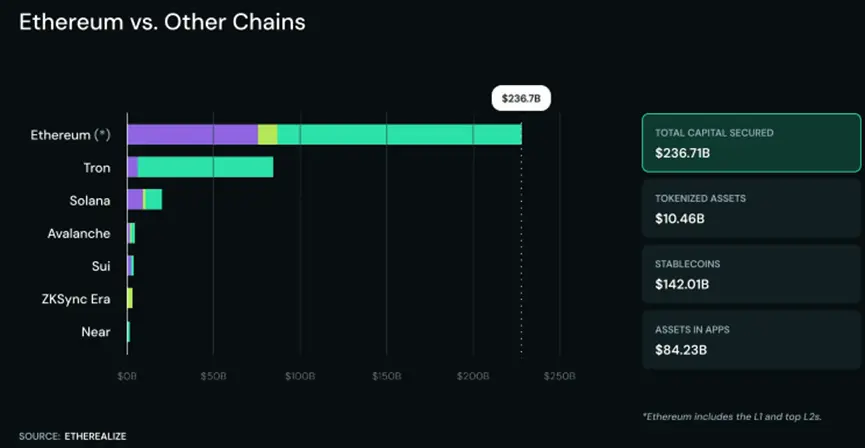
Institutions are beginning to favor digital oil over digital gold, a trend that is expected to continue over the next decade. There are three reasons for this:
1. BTC is idle, ETH is involved in construction. Bitcoin succeeded by acting as a passive store of value. In contrast, Ethereum succeeded because it always maintained efficient output. Ethereum is an indispensable fuel for the world's most decentralized and secure smart contract blockchain. Every operation in Ethereum's vast decentralized financial ecosystem, every NFT minting, and every second-layer network settlement requires ETH as a transaction fee. Since the launch of EIP-1559 in August 2021, Ethereum has burned about 4.6 million ETH, worth about $15.6 billion at current prices, indicating that the asset plays the role of digital oil in the on-chain economy. Today, Ethereum secures about $237 billion in value in L1 and top L2 networks, and as the global economy moves more on-chain, the demand for ETH will continue to grow. Ethereum has a 57% share of the RWA market and a 54.2% share of the total stablecoin supply. In short, Ethereum dominates across multiple metrics, with ETH being the powerhouse of its ecosystem.
2. BTC is inflationary, ETH is gradually becoming anti-inflationary. BTC's supply schedule is fixed, with a current issuance rate of about 0.85%, which will be programmatically reduced over time. As block rewards decrease by 50% every four years, miners will become increasingly dependent on transaction fee income to maintain operations. Some people believe that BTC's security budget is a potential threat. Ethereum has a different monetary policy, directly tied to economic activity. ETH's total issuance is capped at 1.51% to incentivize network security, but because about 80% of transaction fees are destroyed through EIP-1559, ETH's net issuance rate has averaged only 0.1% per year since the merger. ETH often experiences net deflation, and the total supply (currently just under 120 million ETH) is expected to decline as demand for Ethereum block space grows. In other words, as Ethereum becomes more popular, ETH will become increasingly scarce.
3. BTC does not generate any income, ETH is a yield-generating asset. Bitcoin itself does not generate income. But ETH is a high-yield digital commodity. ETH stakers can lock Ethereum as validators and receive a current actual income of about 2.1% (nominal income - new issuance). Stakers can obtain ETH issuance and part of the transaction fees (i.e., the part that will not be destroyed), and there is no counterparty risk, which incentivizes long-term holding and active network participation. The difference between ETH and all other major crypto assets is that as the throughput of the Ethereum economy expands, the yield of validators will also increase.
ETH as the world's leading reserve asset
ETH is the world’s leading reserve asset because it has several unique properties. ETH meets three core requirements in a way that no other asset can:
Pure settlement collateral. As the new economy continues to be built on tokenized assets that bear issuer and jurisdictional risks, the financial system needs a credible, neutral, non-sovereign collateral asset. That asset is ETH. Aside from BTC, ETH is the only “pure” collateral in the on-chain economy that is fully protected against external counterparty risk. Ethereum’s $237 billion in collateral value makes ETH a censorship-resistant cornerstone of the next generation financial system.
High liquidity. ETH is the most liquid and dominant asset in DeFi trading pairs. ETH plays a role in the on-chain economy similar to the role of the US dollar in the traditional foreign exchange market. ETH's deep liquidity and broad utility have prompted DAOs, foundations, and public companies to compete to hoard ETH as a strategic asset. The "Strategic ETH Reserve" is expanding rapidly, and hoarders also benefit from its programmability. BTC sits idle in vaults, while ETH can be deployed through use cases such as staking and collateralized lending.
Protocol-native yield. Corporate treasurers seek yield, but it is not easy to obtain it without taking on significant credit or counterparty risk. ETH staking provides a risk-free yield of 2-4%, which is directly derived from the yield generated by L1 staking. This means treasurers have access to an efficient, cash-flow-generating tool to reserve, directly tying their balance sheet to the growth and security of the new economic base layer.
“Internet Bonds”
Because staking generates native protocol yields, ETH has become the world’s first “internet bond.” Historically, corporate treasurers have typically allocated funds between sovereign bonds (valued at ~$80 trillion) and corporate bonds (valued at ~$40 trillion). ETH staking creates a new class of bonds that have a broad understanding of issuance, risk, and yield profiles. Today, this market is orders of magnitude smaller than the sovereign and corporate bond markets. But unlike corporate and sovereign bonds, ETH has no maturity date and yields are generated in perpetuity. ETH staking also eliminates counterparty risk because the yield is generated by the protocol; there is no risk of default for bond issuers.
ETH is a global, censorship-resistant commodity whose returns are not subject to traditional interest rate cycles. Currently, the Fed's funds rate is between 4.25% and 4.5%. Meanwhile, ETH stakers are currently earning a realized yield of about 2.1%. Capital allocators tend to choose risky assets over short-term Treasuries when interest rates fall due to lower borrowing costs. Institutions' continued interest in staking Ethereum despite higher short-term Treasuries shows a strong conviction in this regard. If interest rates fall, these institutions can benefit from higher yields on the underlying asset, which will appreciate as market risk appetite rises.
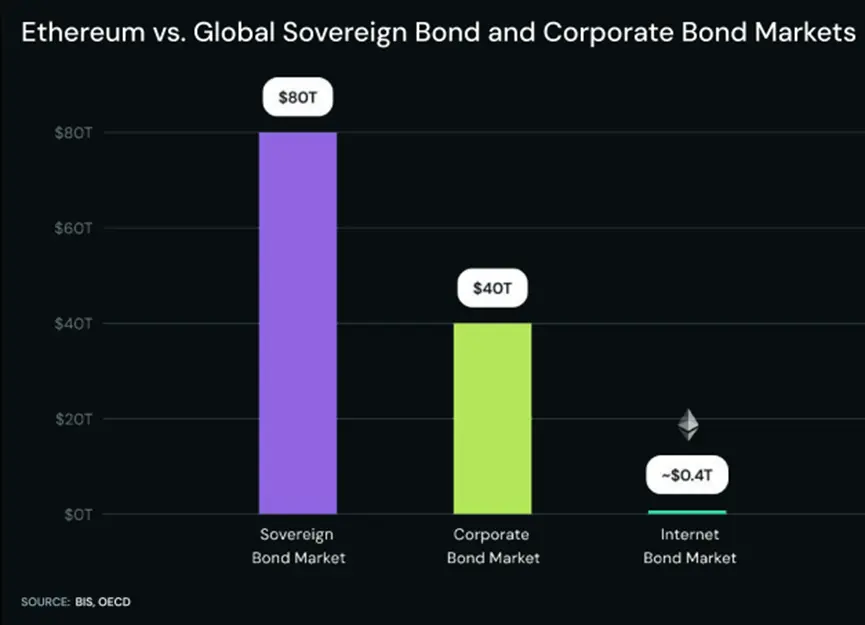
2. Major institutions compete to hoard ETH
Cryptocurrency has firmly established itself as a legitimate asset class, with Bitcoin being the gateway for institutions to enter the space. But Ethereum is its natural evolution. Ethereum combines Bitcoin's store of value appeal while providing native yields and the security of a growing on-chain economy such as stablecoins, RWAs, and DeFi. Strategic Ethereum reserves highlight this major shift: institutions are hoarding ETH as a long-term strategic reserve asset.
Many public companies and Ethereum-native organizations have implemented ETH treasury management strategies. Most strategies are designed to generate income, while others view ETH as a base currency for long-term operations. Many organizations do both.
Data shows that approximately 1.7 million ETH (worth approximately $5.9 billion, or approximately 1.44% of the supply) are currently held in strategic reserves.
Since the strategic reserve race began to heat up in early Q2, the amount of ETH hoarded by institutions has far exceeded the amount of ETH issued to pay validators. As this race intensifies, ETH is under increasing deflationary pressure.
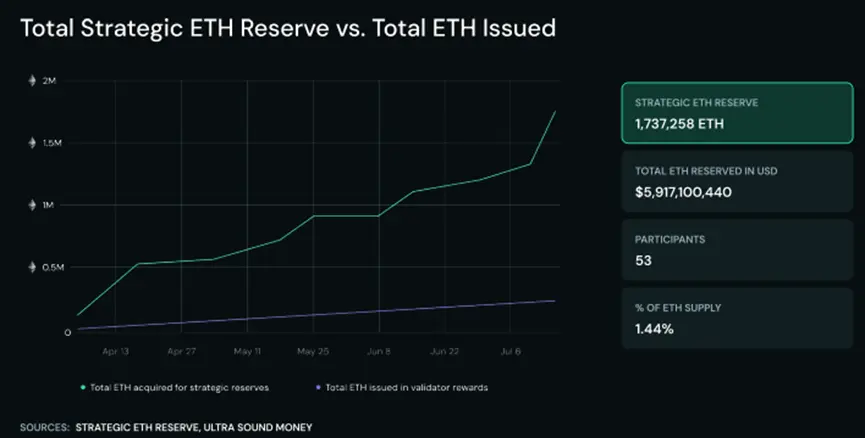
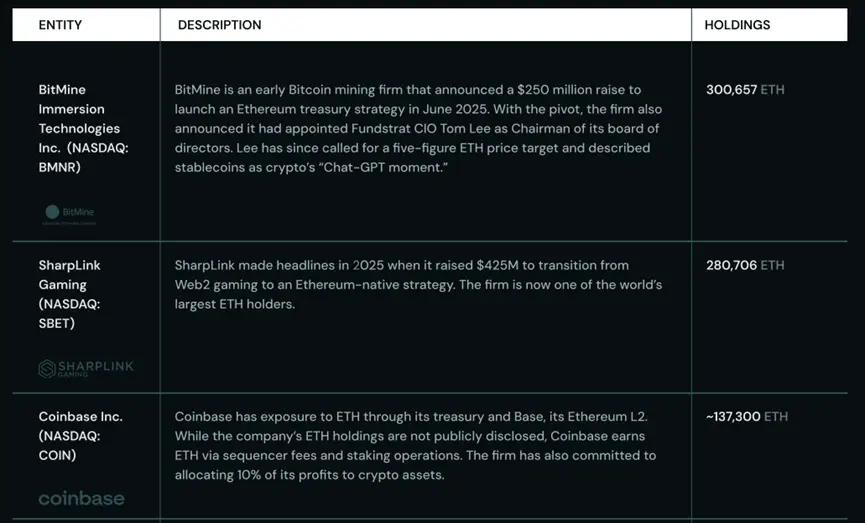
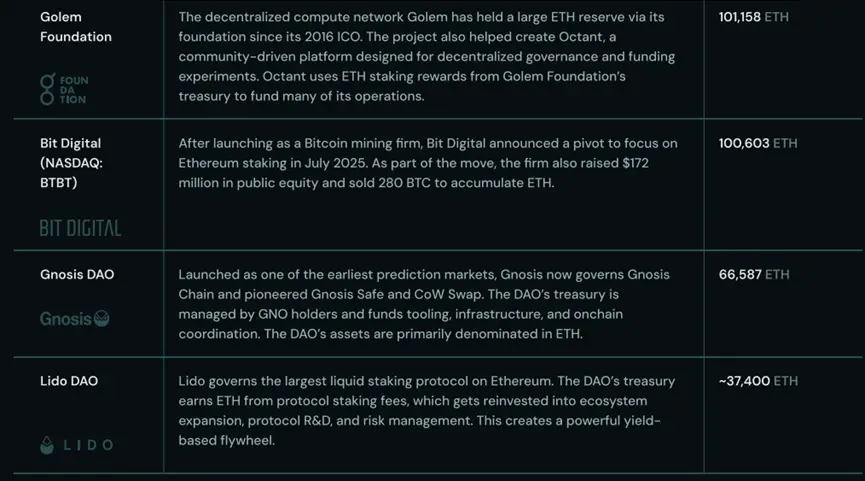
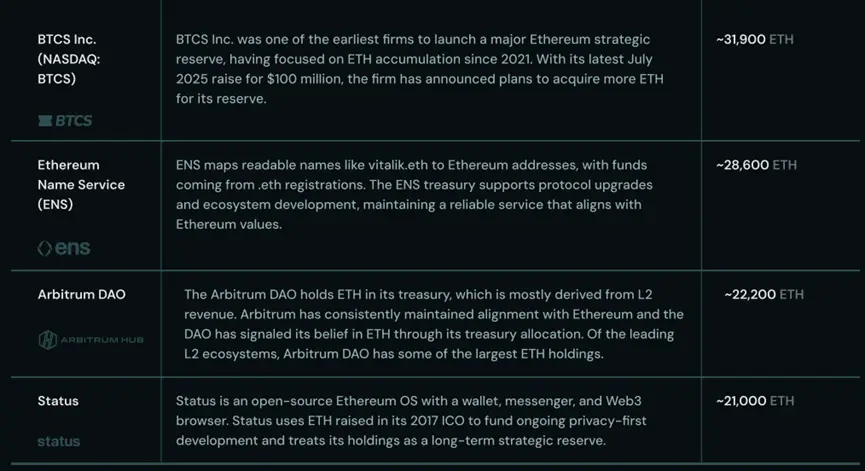
3. ETH is a yield-generating asset
It is clear that institutions are adopting the Ethereum network, and ETH has become their preferred supporting asset. All signs indicate that as Treasury yields fall, institutional demand for ETH staking will soar as these institutions want to earn real returns on their capital, which staking can provide them with minimal risk. Distributed validators play a key role in this process as institutions place great emphasis on security and reducing counterparty risk in their capital allocation strategies.
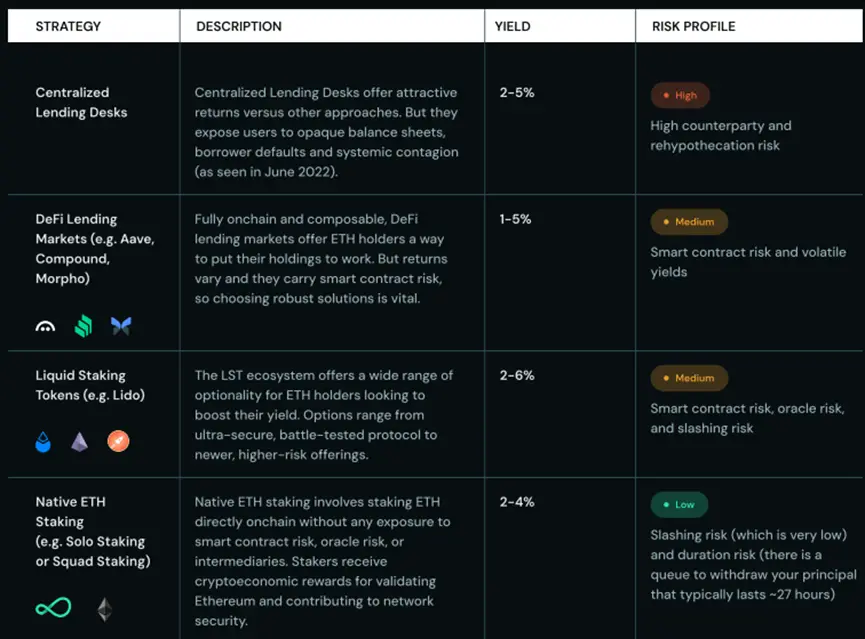
Why Staking Wins (and How Distributed Validators Fit In)
ETH staking is structurally different from all other ETH yield options because it provides a predictable protocol-level yield tied to security incentives and network adoption.
Of all the yield strategies possible for Ethereum holders, staking is the only option that does not create borrower, counterparty, or credit risk.
Institutions like Bit Digital that are associated with Ethereum have realized that staking is the best way to earn returns on their holdings. As more institutions adopt strategic ETH reserve strategies, staking will in turn attract more institutions because it provides a low-risk way to earn returns from the "Internet Bond".
For institutions seeking yield, ETH staking is the best avenue as it offers a near-risk-free rate of return compared to other strategies.
However, while finance executives recognize that native staking is clearly a strategically wise choice, they have other factors to consider. For these institutions, the question is not only whether to stake, but how to stake to achieve institutional-grade security and resilience. While traditional validators are effective, they create a single point of failure. Distributed validators (DVs) solve this problem. Distributed validators have the following characteristics:
A single Ethereum validator (with more than 32 ETH staked) is spread across multiple nodes.
Use Distributed Key Generation (DKG) to avoid single point private key risks.
It can maintain functionality even if up to half of the nodes are offline.
Achieve the same or better performance than traditional validators.
Although the decentralized validator (DV) space is still in its infancy, many institutions building strategic Ethereum reserves are now using DV. They can benefit from the following:
Institutional-grade key security: DV’s keys are never stored in a single location and are inaccessible to any single operator, providing users with a higher level of security.
Fault Tolerance: Users are not exposed to risks posed by a single operator, such as fines or missed rewards.
Middleware Design: The world’s top staking operators trust middleware infrastructure like Obol’s Charon, which provides them with a way to decentralize their operations without major modifications.
No need to hold long-tail assets: The vault does not need to accumulate long-tail assets to stake Ethereum. No need to consider collateral assets, margin or liquidation mechanisms.
4. Why does ETH represent a trillion-dollar opportunity?
ETH is no longer a misunderstood speculative asset. Following Bitcoin, Ethereum is becoming an institutional asset held by large enterprises, DAOs and other institutions. But ETH has an advantage that BTC does not have: it is the foundation of the Ethereum network, which is the cornerstone of the next generation of the financial system. As the first "productive" reserve asset, ETH also has the functions of a credible and neutral value storage, settlement collateral, and interest-bearing reserve asset.
Ethereum has laid the foundation for the next generation of the financial system. Now institutions are recognizing this.
ETH's unique position allows it to become more scarce as adoption increases. As Ethereum's base currency, ETH has a deflationary mechanism, and its supply will decrease as the network grows. No other asset can simultaneously possess these characteristics and provide credible neutrality.
In Ethereum’s first decade, it has established itself as the base layer for transformative innovations such as DeFi, stablecoins, NFTs, and ICOs.
As the second decade begins, Ethereum is entering its institutional era. Major companies view ETH as the premier “productive” asset, and the race to accumulate is accelerating. In this new era, Ethereum’s path to a trillion-dollar network has never been clearer.
Related reading: Ethereum welcomes capital changes! ETH price rebounds sharply, institutional reserve arms race becomes a new turning point





